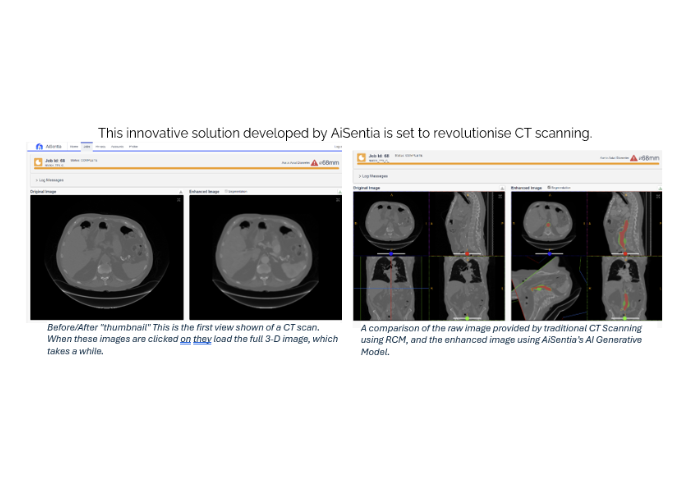AiSentia emerged as a spin-out company from an industry-leading research project at the University of Oxford. Their aim was simple: to alleviate the need for patients undergoing a CT scan to be given an injection of radiological contrast media (RCM). Instead, AiSentia have created a generative AI model that processes CT X-Ray images and enhances them by raising the contrast of the CT images. This improves the visibility of relevant issues within the human body and eliminates the need for RCM.
The System C Innovation Delivery team were able to translate the software script from the original research project into a robust powerful cloud-based solution.
Read on to find out how System C worked with AiSentia to help them produce a prototype product.
The Problem
CT scans, which take detailed pictures of the inside of a patient’s body, are a very widely used diagnostic tool.
“In the NHS alone, ~6 million CT scans were performed each year (~150 million scans globally/ year).” [i]
Traditionally, an injection of RCM must be administered, which can cause several potential issues.
- CT images are becoming much harder to analyse as they only show slightly different shades of greys for various tissues.
- The RCM used is an iodine-based contrast enhancement agent. It is somewhat toxic and cannot be safely distributed to all patients.
- Neither extremely sick nor elderly people can be offered the agent, due to potential complications.
- Conducting CT X-Ray imaging using RCM involves a higher processing time. It requires two trips to the scanner, which means the process is both longer, and more expensive.
The Solution
AiSentia have specifically designed an AI based model to help clinicians to detect abdominal aortic aneurysms. This can prove fatal if it is not detected and treated at an early stage. The newly developed AI software enhances the contrast of the images without RCM and automatically detects the aorta by producing a 3D model of the blood vessel from the CT images. The AI generated model then accurately measures the diameter of the aorta and automatically alerts the user if it exceeds the safe limits.
What did System C do?
System C’s Innovation Delivery team has partnered with AiSentia to develop a working prototype, to enable the application to be deployed within the healthcare sector.
The Innovation Delivery team has developed a secure, user-friendly web front end and a desktop bulk tool to help support the deployment of the application and enhance the accuracy of CT scans. These prototypes will undergo rigorous testing throughout all key stages within its lifecycle. The software processing will be cloud based, which enables data to be effortlessly synchronised and will help to optimise data flow. Whilst cloud processing allows a streamlined communication process it also helps to increase security and protect patient data as well as making it more accessible to clinicians.
System C’s product team helped establish a Python script from AiSentia’s MATLAB code which enabled the generation of contrast enhancements of the affected areas of the body. Although AiSentia’s model is not yet available for clinical use, a prototype of the product was forged. As a result of the collaboration AiSentia now have an excellent quality prototype of their image enhancement system, which is suitable for further development as a medical device. By generating a prototype of AiSentia’s vision System C can gauge production costs, test functionalities, and gain constructive feedback from clinicians and regulators. This prototype gives AiSentia a strong platform to support clinical validation for their approach.
‘We were able to convert the python pipeline in such a way that we could host it on a generic cloud platform, without requiring a GPU or other specialised hardware.’
Achievements
AiSentia’s technology successfully eliminates the need for harmful contrast agents which cause discomfort and unnecessary radiation exposure. It also provides a pathway to seamlessly integrate into the current clinical workflow.
By achieving AiSentia’s vision, CT and X-Ray scans can become more efficient and help radiology departments raise their productivity by up to 100%.
James Greig, our lead product developer shared his thoughts on AiSentia’s solution,
‘This software could provide huge support for radiographers; it would help them to save time, investigate more cases, and thus save more lives.’
Next Steps
We are experienced in developing complex software solutions for the healthcare industry. Please contact us to discuss your ideas, we would love to hear from you.



